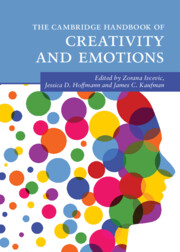Book contents
- The Cambridge Handbook of Creativity and Emotions
- Cambridge Handbooks in Psychology
- The Cambridge Handbook of Creativity and Emotions
- Copyright page
- Dedications
- Contents
- Figures
- Tables
- Contributors
- Acknowledgments
- Creativity and Emotions
- Part I Methods in the Study of Creativity and Emotions
- Part II The Development of Creativity
- Part III Emotions and the Creative Person
- Part IV Emotions and Creative Products
- Part V Emotions and Creativity at School and Work
- 24 Anxiety, Fear of Failure, and Creativity
- 25 Peers, Affect, and Creativity at School
- 26 Creative Curricular Experiences
- 27 Organizational Affective Climate and Creativity at Work
- 28 Group Affect and Creativity
- 29 Psychological Safety and Creativity
- 30 Leadership, Creativity, and Emotions
- 31 A Multilevel Model of Emotions and Creativity in Organizations
- 32 Creativity and Emotion
- Index
- References
32 - Creativity and Emotion
Connecting the Dots
from Part V - Emotions and Creativity at School and Work
Published online by Cambridge University Press: 16 February 2023
- The Cambridge Handbook of Creativity and Emotions
- Cambridge Handbooks in Psychology
- The Cambridge Handbook of Creativity and Emotions
- Copyright page
- Dedications
- Contents
- Figures
- Tables
- Contributors
- Acknowledgments
- Creativity and Emotions
- Part I Methods in the Study of Creativity and Emotions
- Part II The Development of Creativity
- Part III Emotions and the Creative Person
- Part IV Emotions and Creative Products
- Part V Emotions and Creativity at School and Work
- 24 Anxiety, Fear of Failure, and Creativity
- 25 Peers, Affect, and Creativity at School
- 26 Creative Curricular Experiences
- 27 Organizational Affective Climate and Creativity at Work
- 28 Group Affect and Creativity
- 29 Psychological Safety and Creativity
- 30 Leadership, Creativity, and Emotions
- 31 A Multilevel Model of Emotions and Creativity in Organizations
- 32 Creativity and Emotion
- Index
- References
Summary
The concluding chapter reflects on the contributions across five parts of the Handbook. We consider the threads connecting specific chapters within the topical sections devoted to the methodology of studying creativity and emotion, creative process, creative person, creative product, and creative contexts. In this reflection, we pay special attention to what is missing and what are key directions for future research. We propose an integrative model describing the role of affective processes across different aspects of creativity. The model discusses the need to specify the nature of creativity being studied (in terms of time, potential vs. actualization, and locus of judgment of creativity), as well as levels in which the role of emotions in creativity manifest itself (individual, dyadic, group, institutional, cultural). The process model of affective influences on creativity describes the role of affective states, emotion-related traits, and emotion abilities at different points from facing or initiating creative problems to creative beliefs and intentions, creative behavior, and creative products or achievements.
Keywords
- Type
- Chapter
- Information
- The Cambridge Handbook of Creativity and Emotions , pp. 620 - 640Publisher: Cambridge University PressPrint publication year: 2023
References
- 2
- Cited by

